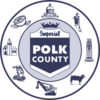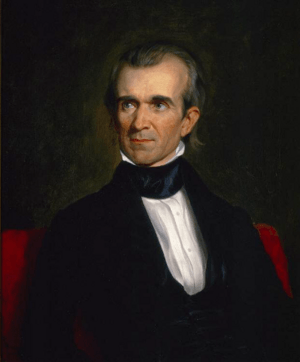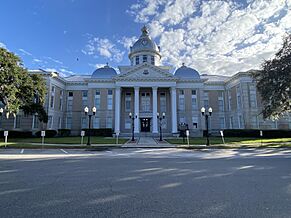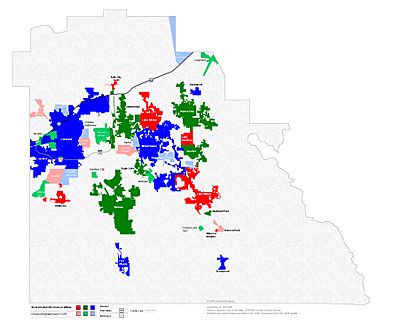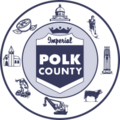Polk County, Florida facts for kids
Quick facts for kids
Polk County
|
|||||
|---|---|---|---|---|---|

Polk County courthouse in Bartow
|
|||||
|
|||||
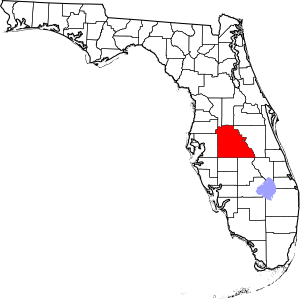
Location within the U.S. state of Florida
|
|||||
 Florida's location within the U.S. |
|||||
| Country | |||||
| State | |||||
| Founded | February 8, 1861 | ||||
| Named for | James K. Polk | ||||
| Seat | Bartow | ||||
| Largest city | Lakeland | ||||
| Area | |||||
| • Total | 2,011 sq mi (5,210 km2) | ||||
| • Land | 1,798 sq mi (4,660 km2) | ||||
| • Water | 213 sq mi (550 km2) 10.6% | ||||
| Population
(2020)
|
|||||
| • Total | 725,046 | ||||
| • Estimate
(2023)
|
818,330 |
||||
| • Density | 360.54/sq mi (139.21/km2) | ||||
| Time zone | UTC−5 (Eastern) | ||||
| • Summer (DST) | UTC−4 (EDT) | ||||
| Area code | 863 | ||||
| Congressional districts | 11th, 15th, 18th | ||||
Polk County is a county located in the central part of Florida, a state in the United States. In 2020, about 725,046 people lived here. By July 2023, this number grew to an estimated 818,330 people.
The main city where the county government is located is Bartow. The biggest city in Polk County is Lakeland. Together, Lakeland and Winter Haven form a large metropolitan area. The center of Florida's population is actually in Polk County, near Lake Wales.
Polk County is also home to several colleges and universities.
Contents
History of Polk County
The first people came to Polk County nearly 12,000 years ago. They were called Paleo-Indians, and they were hunters and gatherers who followed large animals. Florida's shape changed a lot back then due to sea levels. Sometimes it was much wider, and other times it was mostly underwater.
Later, "archaic people" lived here. They were the ancestors of the Native Americans who met the Spanish explorers. It's thought that over 250,000 Native Americans lived in Florida in 1492.
When Europeans arrived, they brought diseases like Smallpox and measles. Native Americans had no protection against these illnesses, which caused many deaths. Some were also killed or enslaved by the explorers. Because of this, most of the Native American population in Polk County disappeared over a few hundred years. The remaining Native Americans joined with Creek Indians from Georgia and the Carolinas to form the Seminole Tribe.
For about 250 years after Ponce De Leon arrived, Spain ruled Florida. Later, the French and British also ruled for a short time. After the American Revolution, Florida briefly went back to Spanish rule. In 1819, Florida became a U.S. territory. It became a U.S. state in 1845.
Polk County is Created
Polk County was officially created in 1861. It was formed from the eastern part of Hillsborough County. The county was named after James K. Polk, who was a President of the United States. He became president the day after Florida became a state.
After the Civil War, the county decided to put its main government office, called the county seat, in the middle of the county. This new town was named Bartow. It was named after Francis S. Bartow, a Confederate Colonel from Georgia. The first courthouse in Bartow was built in 1867. It was replaced twice, in 1884 and 1908. The building that stands today is the third courthouse. It now holds the Polk County Historical Museum and Genealogical Library.
Recent Changes in Polk County
Polk County has grown a lot recently. This is because it is close to both Tampa and Orlando. The areas closest to these big cities, like Lakeland and Haines City, have seen the most growth.
In 2004, three hurricanes, Charley, Frances, and Jeanne, all passed over Polk County. Their paths crossed in a triangle shape over the city of Bartow.
Winter Haven was once famous for Cypress Gardens, a theme park that closed in 2009. Now, the theme park Legoland Florida is built on the same spot. Winter Haven was also where the first Publix supermarket opened around 1930. Publix's main offices are now in Lakeland.
Geography of Polk County
Polk County covers a total area of about 2,011 square miles. About 1,798 square miles of this is land, and 213 square miles (10.6%) is water. It is the fourth-largest county in Florida by land area. It is the fifth-largest by total area.
Neighboring Counties
Polk County shares borders with many other counties:
|
|
|
Polk County also touches Orange County at a special point called Four Corners, Florida. Lake and Osceola counties are also at this spot.
People of Polk County
| Historical population | |||
|---|---|---|---|
| Census | Pop. | %± | |
| 1870 | 3,169 | — | |
| 1880 | 3,181 | 0.4% | |
| 1890 | 7,905 | 148.5% | |
| 1900 | 12,472 | 57.8% | |
| 1910 | 24,148 | 93.6% | |
| 1920 | 38,661 | 60.1% | |
| 1930 | 72,291 | 87.0% | |
| 1940 | 86,665 | 19.9% | |
| 1950 | 123,997 | 43.1% | |
| 1960 | 195,139 | 57.4% | |
| 1970 | 227,222 | 16.4% | |
| 1980 | 321,652 | 41.6% | |
| 1990 | 405,382 | 26.0% | |
| 2000 | 483,924 | 19.4% | |
| 2010 | 602,095 | 24.4% | |
| 2020 | 725,048 | 20.4% | |
| 2023 (est.) | 818,330 | 35.9% | |
| U.S. Decennial Census 1790–1960 1900–1990 |
|||
2020 Census Information
In 2020, Polk County had 725,046 people. There were 240,879 households and 165,183 families living in the county.
| Race | Pop 2010 | Pop 2020 | % 2010 | % 2020 |
|---|---|---|---|---|
| White (NH) | 388,769 | 392,621 | 64.57% | 54.15% |
| Black or African American (NH) | 85,336 | 100,950 | 14.17% | 13.92% |
| Native American or Alaska Native (NH) | 1,658 | 1,623 | 0.28% | 0.22% |
| Asian (NH) | 9,567 | 13,181 | 1.59% | 1.82% |
| Pacific Islander (NH) | 238 | 300 | 0.04% | 0.04% |
| Some other race (NH) | 1,083 | 3,684 | 0.18% | 0.51% |
| Mixed/multiracial (NH) | 8,912 | 24,992 | 1.48% | 3.45% |
| Hispanic or Latino | 106,532 | 187,695 | 17.69% | 25.89% |
| Total | 602,095 | 725,046 | 100% | 100% |
2010 Census Information
In 2010, the largest groups of people by their family background were:
- 12.2% German
- 11.6% American
- 11.2% English
- 10.8% Irish
- 7.6% Mexican
- 5.8% Puerto Rican
There were 227,485 households. About 27.3% of these households had children under 18 living with them. About 51.1% were married couples.
The average age of people in the county was 39.8 years. About 23.5% of the population was under 18 years old.
Languages Spoken
As of 2010, most people (81.80%) in Polk County spoke English as their main language. About 14.34% spoke Spanish. Other languages spoken included Haitian Creole and French. In total, 18.20% of the population spoke a language other than English at home.
Economy of Polk County
Polk County's economy has over 275,000 workers. For a long time, the biggest industries here have been phosphate mining, agriculture (farming), and tourism.
Some well-known companies that have their main offices in Polk County include Publix, a grocery store chain, and Florida's Natural, which is a group of farmers who work together.
Major Employers
Here are some of the largest employers in Polk County:
- Polk County Public Schools (13,000 employees)
- Publix (11,721 employees)
- Lakeland Regional Health (5,605 employees)
- Walmart (5,100 employees)
- City of Lakeland (2,300 employees)
- GEICO (2,222 employees)
- Polk County Board of County Commissioners (2,200 employees)
- Winter Haven Hospital (2,079 employees)
- Polk County Sheriff's Office (1,955 employees)
- Watson Clinic (1,851 employees)
- Southeastern University (1,557 employees)
- Legoland Florida (1,500 employees)
- The Mosaic Company (1,380 employees)
- Sykes (1,150 employees)
- State Farm Insurance (1,000 employees)
- Amazon (1,000 employees)
- GC Services (1,000 employees)
- Polk State College (932 employees)
- Rooms to Go (900 employees)
- Florida's Natural Growers (645 employees)
- CSX Transportation (599 employees)
Sports in Polk County
Polk County has professional baseball and basketball teams. It also has a strong history of college sports. For example, Florida Southern College often competes for national championships in NCAA Division II.
Professional baseball, especially major league spring training, used to bring many tourists to Polk County. Today, only the Detroit Tigers still come here for spring training. The Single-A team, the Lakeland Flying Tigers, plays in Joker Marchant Stadium after spring training.
Professional basketball started in 2017 with the Lakeland Magic. This team was part of the NBA G League, which helps develop players for the NBA's Orlando Magic. In 2023, the team moved to Osceola County.
College sports are also popular. The Florida Southern Moccasins play in NCAA Division II. The Southeastern Fire play in NAIA.
Education in Polk County
Polk County Public Schools manages the public schools in the county.
Universities and Colleges
Public Universities
- Florida Polytechnic University
Public Colleges
- Polk State College (used to be called Polk Community College)
Private Institutions
- Southeastern University
- Florida Southern College
- Warner University
- Webber International University
- Keiser University, Lakeland Campus
- Southern Technical College, Auburndale Campus
Polk County Library Cooperative
The Polk County Library Cooperative started on October 1, 1997. It was created by an agreement between the 13 cities with public libraries and the county government. This cooperative lets all residents of Polk County use any public library in the county, even if they live outside a city.
Borrowing Books from Other Libraries
The Interlibrary Loan (ILL) service lets library users ask for books that their local library doesn't have. Through ILL, you can get books from any library in Polk County, all of Florida, and even from universities and public libraries across the United States.
Libraries in the Cooperative
|
|
|
Services Provided by the Cooperative
|
|
Polk County Historical and Genealogical Library
Library History
The Polk County Historical and Genealogical Library started in 1937 and opened in January 1940. It was first in the county attorney's office with books in a metal bookcase. Over the years, it moved to different spots in the old Polk County Courthouse. In 1968, the library hired its first full-time staff member.
In 1987, the library moved back to the 1908 Courthouse. It was updated over 10 years and now uses all three floors of the courthouse's eastern side. Since 2013, the library has been in the east wing of the historic courthouse in Bartow. It is managed by the Polk County government. This library has one of the largest collections of historical and family history information in the Southeastern United States.
Collections and Services
The Polk County Historical and Genealogical Library has over 40,000 items. These include books, microfilm, and magazines about the history and family trees of the entire Eastern United States. For Polk County's history, they have local newspapers from 1881, aerial photos from 1938, city guides from 1925, and property tax records from 1882. Four full-time staff members are there to help. The library also helps with finding old obituaries and basic information by email.
Fun Places to Visit
- Bok Tower Gardens
- Child of the Sun
- Dundee station
- Explorations V Children's Museum
- Fantasy of Flight
- Florida Air Museum
- Homeland Heritage Park
- Lake Kissimmee State Park
- Lake Wales station
- Legoland Florida
- Mulberry Phosphate Museum
- Old Fort Meade School House
- Polk County Historical Museum
- Polk Museum of Art
- Polk's Nature Discovery Center
- Posner Park
- Saddle Creek Park
- Water Ski Hall of Fame and Museum
Media in Polk County
Polk County is part of the Tampa Bay media market. This means it gets news and entertainment from that larger area.
Newspapers
- The Polk County Democrat (since 1931)
- The Lakeland Ledger (since 1924)
- The Winter Haven News Chief (since 1911)
- The Business Observer (since 1997)
Radio Stations
| Callsign | City | Type of Music/Talk |
|---|---|---|
| WLLD | Lakeland | Rhythmic contemporary (popular dance music) |
| WLKF | News Talk Information | |
| WPCV | Country music | |
| WSEU | Contemporary Christian music, sports | |
| WWBF | Bartow | Classic hits music and Bartow High School sports |
| WLVF | Haines City | Southern gospel music |
Television
- WMOR-TV (licensed to Lakeland, with studios in Tampa)
Transportation in Polk County
Airports
- Lakeland Linder International Airport (became international in 2017)
- Bartow Municipal Airport
- Lake Wales Municipal Airport
- Jack Browns Seaplane Base
- Winter Haven's Gilbert Airport
- South Lakeland Airport
- Chalet Suzanne Air Strip
- River Ranch resort Airport
Major Roads
- Interstate Highways
 I-4 (Interstate 4) – This highway goes across the northern part of the county. It connects Tampa and Lakeland in the west to Orlando in the northeast.
I-4 (Interstate 4) – This highway goes across the northern part of the county. It connects Tampa and Lakeland in the west to Orlando in the northeast. SR 570 (or Polk Parkway) – This is a toll road that mainly goes around Lakeland. It connects to I-4 and provides access to Winter Haven and Legoland.
SR 570 (or Polk Parkway) – This is a toll road that mainly goes around Lakeland. It connects to I-4 and provides access to Winter Haven and Legoland.- Central Polk Parkway (being built)
- Heartland Parkway (planned)
- U.S. Highways
 US 17 – This highway enters from the southwest, goes through Bartow and Winter Haven, and then heads towards Kissimmee and Orlando.
US 17 – This highway enters from the southwest, goes through Bartow and Winter Haven, and then heads towards Kissimmee and Orlando. US 27 – This is a main road in eastern Polk County. It passes through cities like Frostproof, Lake Wales, and Haines City. It connects to I-4, leading to the Orlando area.
US 27 – This is a main road in eastern Polk County. It passes through cities like Frostproof, Lake Wales, and Haines City. It connects to I-4, leading to the Orlando area. US 92 – This road runs mostly parallel to I-4. It goes through Lakeland and Auburndale.
US 92 – This road runs mostly parallel to I-4. It goes through Lakeland and Auburndale. US 98 – This road crosses Polk County from northwest to southeast. It goes through Lakeland, Bartow, and Frostproof.
US 98 – This road crosses Polk County from northwest to southeast. It goes through Lakeland, Bartow, and Frostproof. US 192 – This highway starts at US 27 near the Polk and Lake County border. It goes east towards Disney World and Orlando.
US 192 – This highway starts at US 27 near the Polk and Lake County border. It goes east towards Disney World and Orlando.
- Main State Roads
 SR 17 – This scenic highway runs next to US 27. It goes through downtown Lake Wales, Dundee, and Haines City.
SR 17 – This scenic highway runs next to US 27. It goes through downtown Lake Wales, Dundee, and Haines City. SR 33 – This road goes north from Lakeland to Polk City.
SR 33 – This road goes north from Lakeland to Polk City. SR 37 – Also called South Florida Avenue, it connects Mulberry to southern Lakeland.
SR 37 – Also called South Florida Avenue, it connects Mulberry to southern Lakeland. SR 60 – This is a major road in southern Polk County. It connects Mulberry and Bartow with Lake Wales.
SR 60 – This is a major road in southern Polk County. It connects Mulberry and Bartow with Lake Wales. SR 540 – This road goes from Highland City to Winter Haven. It also provides access to Legoland and US 27.
SR 540 – This road goes from Highland City to Winter Haven. It also provides access to Legoland and US 27. SR 542 – This road goes through central Polk County, connecting Winter Haven to US 27 and Dundee.
SR 542 – This road goes through central Polk County, connecting Winter Haven to US 27 and Dundee. SR 544 – This road connects Auburndale to Winter Haven and then to Haines City.
SR 544 – This road connects Auburndale to Winter Haven and then to Haines City. SR 559 – This road goes around Lake Ariana in Auburndale and connects to Polk City and I-4.
SR 559 – This road goes around Lake Ariana in Auburndale and connects to Polk City and I-4.
Train Travel
Polk County has two Amtrak train stations: one in Winter Haven and one in Lakeland. Both stations are served by Amtrak's Silver Star train. The Winter Haven station also has service from Amtrak's Silver Meteor train.
Communities in Polk County
According to the 2010 Census, almost 38% of the people in Polk County live in one of its seventeen cities or towns. The largest city is Lakeland, with over 97,000 residents. It is on the western side of the county. Winter Haven is in the eastern part and has about 34,000 residents.
Bartow, the county seat, has over 17,000 residents. It is located southeast of Lakeland and southwest of Winter Haven. These three cities form a rough triangle.
Other major cities with over 10,000 people include Haines City, Auburndale, and Lake Wales. Haines City is in the northeast and has over 20,000 residents. Auburndale is northwest of Winter Haven, and Lake Wales is about 16 miles east of Bartow.
Cities
Towns
Village
- Highland Park
Census-Designated Places (CDPs)
These are areas that are like towns but are not officially incorporated as cities or towns.
- Alturas
- Babson Park
- Bradley Junction
- Combee Settlement
- Crooked Lake Park
- Crystal Lake
- Cypress Gardens
- Four Corners
- Fuller Heights
- Fussels Corner
- Grenelefe
- Highland City
- Homeland
- Inwood
- Jan Phyl Village
- Kathleen
- Lakeland Highlands
- Loughman
- Medulla
- Poinciana
- Wahneta
- Waverly
- Willow Oak
Other Unincorporated Communities
These are smaller communities that are not officially part of any city or town.
Images for kids
See also
In Spanish: Condado de Polk (Florida) para niños



